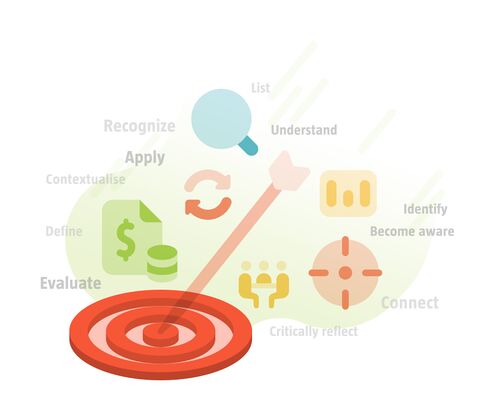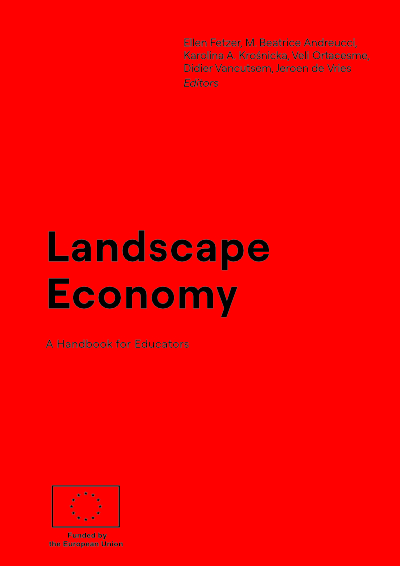TELOS Outputs
Output 1: TELOS Landscape Economy curriculum
Curriculum design and educational resources:
- You can find all learning materials open access on ILIAS via this link
- TELOS Learning Objectives
- Learn more about TELOS Assignments
- Explore the TELOS Landscape Economy reading list
- Download TELOS Curriculum Exhibition Posters
TELOS Learning Activities:
- TELOS Online Course October 2022 - January 2023
- TELOS Online Course October 2023 - January 2024
- TELOS Online Course October 2024 - January 2025
- TELOS Intensive Study Programme June 2023
- TELOS Intensive Study Programme February 2024
Output 2: TELOS Landscape Economy Handbook for Educators
This book presents our approach to integrating a landscape economy dimension into higher education.
It is addressed in particular to teachers motivated to develop knowledge and competences for sustainable development and social-economic transformation. Landscape economy is not restricted to any specific discipline. We all live and work in and with landscapes and we do that through an economic system. However, we think that this book is of particular interest for educators in the fields of spatial planning, urban planning, architecture, landscape architecture, economics, business administration, real estate, mobility, agriculture, geography and regional development.
Broader keywords are: integrated planning, transformative science, systems thinking, social innovation and social entrepreneurship.
Landscape economy forces teachers and learners into deep systems thinking across scales and spaces, sectors and interests, communities and institutions.
The concept is, first of all, confusing and disorienting.
Before diving deeper into this challenge, it seems important to clarify that there is no such thing as a landscape economy method which we could easily adopt and apply to any given context. Instead, landscape economy needs to be understood as a way of framing system boundaries, system elements and system dynamics within a specific territorial context.
Within these frameworks, transition and innovation pathways are always unique and context-specific.Therefore, what we are trying to explain in this book, is a way of taking systemic perspectives on the landscape, guided by the normative dimensions of regeneration, sustainability, fairness and diversity.
The book is divided into four parts:
- The first part is titled Mapping the Terrain and starts with a broader argumentation of why a landscape economy approach is necessary. For example, the theory of the planetary boundaries explains the urgency for global regeneration of natural resources and the need for a deep transformation of how humans work with nature. This is followed by definitions of our key concepts which are ‘landscape’ and ‘economy’. We use here the example of the global-value added chain to exemplify the relationship of economy and territory, leading to the three main characteristics of a sustainable economy system, namely efficiency, consistency and sufficiency. The chapter also includes a reflection on systems thinking, which is a key dimension of knowledge creation and a guiding principle of the landscape economy curriculum design. We also suggest here our definition of landscape economy, knowing that it is rather a state of mind than a tangible method.
- The second part presents what we call Landscape Economy Stories. It brings in the broad cultural and disciplinary perspectives of the five countries present in the landscape economy ERASMUS team. The idea is to create a better understanding of what is driving the different land use sectors that are typically competing for the same territory. The book contains Introducing the Landscape Economy Handbook for Educators 9eight stories: The Commons, Mobility, Dwelling, Energy Landscapes, Positive Energy Districts, Tourism, Agriculture and Urban Forestry. There are always more stories to tell of course. Each story follows more or less the same pattern. We start by setting the scene: What is driving this sector? Which sustainability conflicts is this sector not only facing but also creating? Which major tradeoffs with other landscape values are prevalent? On that basis, each chapter tries to show at least one example of a positive transition pathway and to tell a story of positive change. We learn about new models with innovative governance structures and value propositions. The authors further discuss which indicators of success are relevant: What is the specific contribution of this sector to an overall landscape economy? We learn that indicators, or so called key performance indicators (KPIs), are different for every sector, and yet, they all come together in
one landscape. Each chapter closes with a suggestion of research and analysis questions for landscape economy learners and provides references for further reading.
- The third part explains in great detail how the landscape economy curriculum has been developed and what are the elements of the instructional design. We also introduce the various open access elements which are available to other educators and the learners. At the beginning, we elaborate broadly on the learning objectives of the landscape economy curriculum taking both the cognitive process and the knowledge dimensions into account. We then explain how we have tested the curriculum as part of our educational action research cycle by which we have been able to generate continuous evidence and greatly learn through and from the process. Educators interested in a landscape economy approach find access to all learning materials and recordings, detailed explanations of the assignment descriptions, evaluation forms and all conceptual considerations we have made.
- Part four, Reflection in Action, finishes with a detailed presentation of our evaluation findings highlighting the key learnings of everyone involved, and reflecting on the development needs that still remain.
The book finishes with a glossary of some key landscape economy terms.
We hope you will find this approach inspiring for your own educational activities.


